International Dragonfly Fund – Report 127-133
Journal of the International Dragonfly Fund. Sammelband
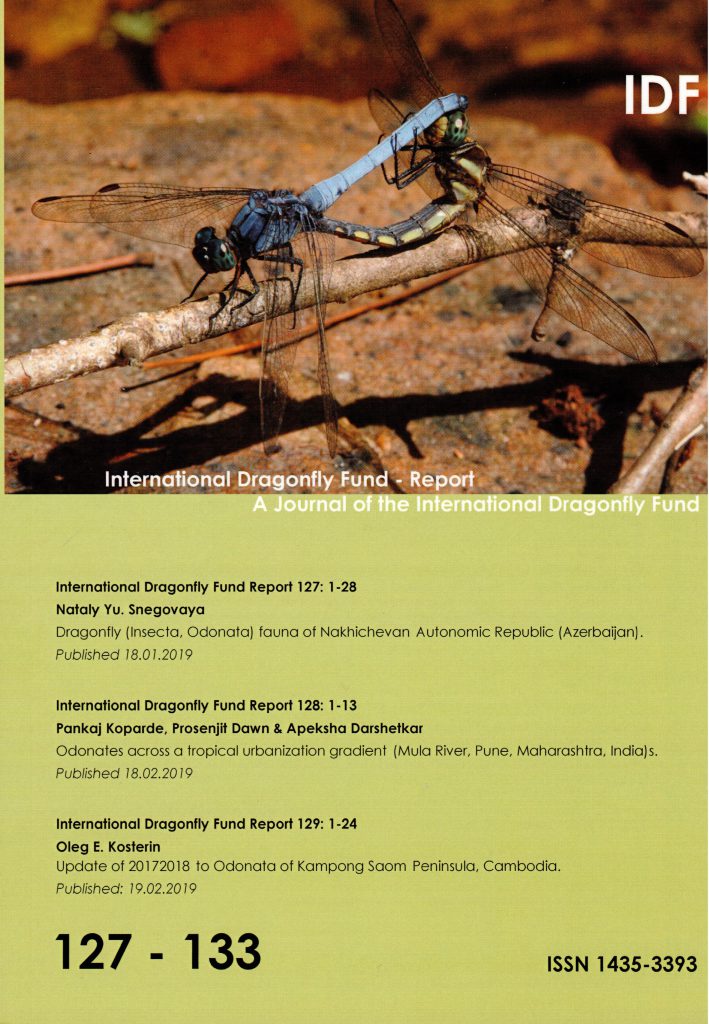
Erscheinungsjahr: 2019
Seitenzahl: 166 (Ca. 260 Farbfotos, 18 Tabellen, 3 Diagramme, 7 Verbreitungskarten)
Format: 21 cm x 15cm (Paperback)
ISBN: 978-3-931921-26-2
Preis: 18,90 €
Dieser Sammelband enthält 6 Forschungsarbeiten mit insgesamt 165 Seiten sowie zahlreichen Farbfotos, Verbreitungskarten, Tabelle und Diagrammen:
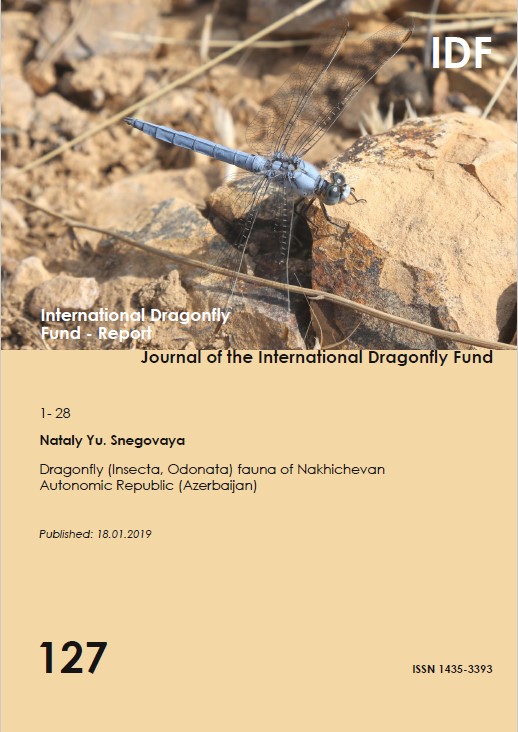
IDF-Report 127: Nataly Yu. Snegovaya (2019) – Dragonfly (Insecta, Odonata) fauna of Nakhichevan Autonomic Republic (Azerbaijan). 28 Seiten, 47 Farbfotos, 1 farbige Karte
The article presents new faunistic data on 33 Odonata species, based on the material collected by the author in 2012, 2016 and 2017 and a systematic research in 2018 throughout the Nakhichevan Autonomous Republic (AR). Onychogomphus assimilis (Schneider, 1845) is a new record for the fauna of Azerbaijan. Eight species were registered for the first time for the territory of Nakhichevan AR: Lestes virens Rambur, 1842, Coenagrion scitulum (Rambur, 1842), Aeshna mixta Latreille, 1805, Anaciaeschna isoceles (Müller, 1764), Anax parthenope (Selys, 1839), Sympetrum sanguineum (Müller, 1764), Crocothemis erythraea (Brullé, 1832), and Selysiothemis nigra (Vander Linden, 1825).
Key words: Odonata, fauna, Nakhichevan Autonomic Republic, Azerbaijan, Onychogomphus assimilis.
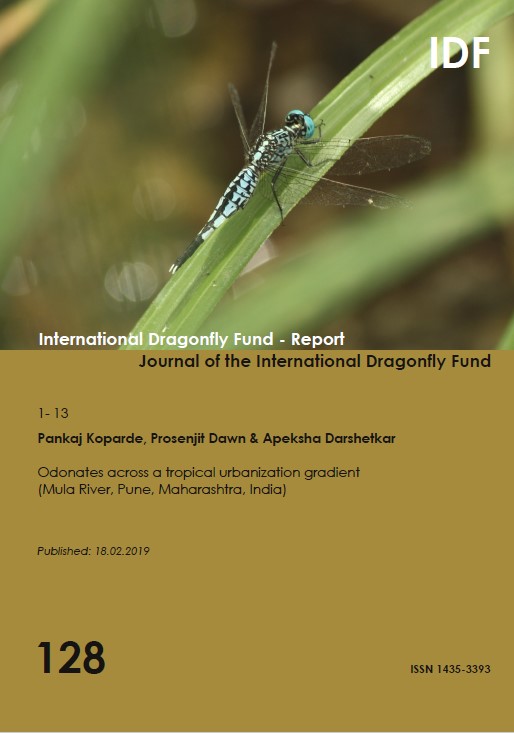
IDF-Report 128: Pankaj Koparde, Prosenjit Dawn & Apeksha Darshetkar (2019) – Odonates across a tropical urbanization gradient (Mula River, Pune, Maharashtra, India). 14 Seiten, 11 Farbfotos, 3 Tabellen
Globally urban wetlands are under high anthropogenic pressure of degradation. Urban wetlands are hotspots for species losses and rapid turnover in species assemblages. Therefore, studying such wetlands may provide an estimate of the pace of local extinction, concerning wetlanddependent species such as odonates. We undertook a study to document odonate species across a tropical urbanization gradient. We sampled six localities across the gradient across the Mula River that flows through the Pune City, India. We sampled adult odonates using a newly devised Halfcircle Point Count method from September 2016 to March 2017. We took multiple temporal replicates per site. We also sampled larvae across six sites once in November 2016. We measured site characteristics such as canopy cover, solid waste, and water turbidity to understand the level of disturbance at each site. We recorded 41 odonates, six species (primarily Gomphidae members) exclusively from the larval sampling. We did not find the localization of species in a particular site across the urbanization gradient, possibly because we sampled a relatively short stretch of the river to capture the variation. Here, we update the Odonata list of Pune including data on larvae. We demonstrate that larval sampling complements Odonata surveys, especially in recording Gomphids. We recommend future research to include a longer timespan and extensive sampling area.
Key words: Gomphids, Larval sampling, Mula River, Species assemblage, Urban wetlands
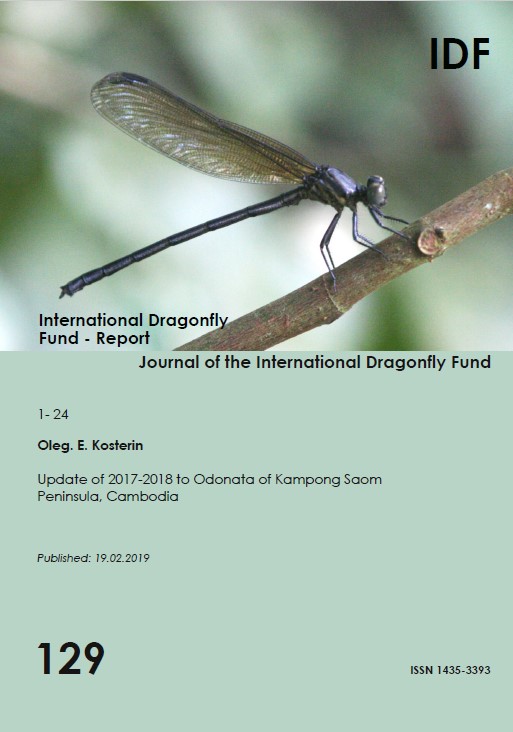
IDF-Report 129: Oleg E. Kosterin (2019) – Update of 2017 – 2018 to Odonata of Kampong Saom Peninsula, Cambodia. 24 Seiten, 27 Farbfotos, 1 Tabelle
New data on Odonata of the Preah Sihanouk Province of Cambodia obtained in March 2017 and November 2018 are presented. The presence of Onychargia atrocyana Selys, 1865 in Cambodia is confirmed. Twentyone species are added to the known fauna of the Kbal Chhay Waterfall environs, 19 species to that of Ream Peninsula and 4 to that of Koh Rong Island. The total number of species registered for Kampong Saom Peninsula amounts to 74. The presented data are rather of historical importance since most of the remaining forest has been quickly and irreversibly logged a few months ago. The validity of Gynacantha demeter Ris, 1911 as a species distinct from G. dohrnii Krüger, 1899 is doubted.
Key words: Odonata, dragonflies, damselflies, fauna, Cambodia, Preah Sihanouk Province, Kampong Saom Peninsula, Ream Peninsula, nature extermination, national Preah Sihanouk Ream National Park, Gynacantha demeter Ris, 1911; Gynacantha dohrni Krüger, 1899
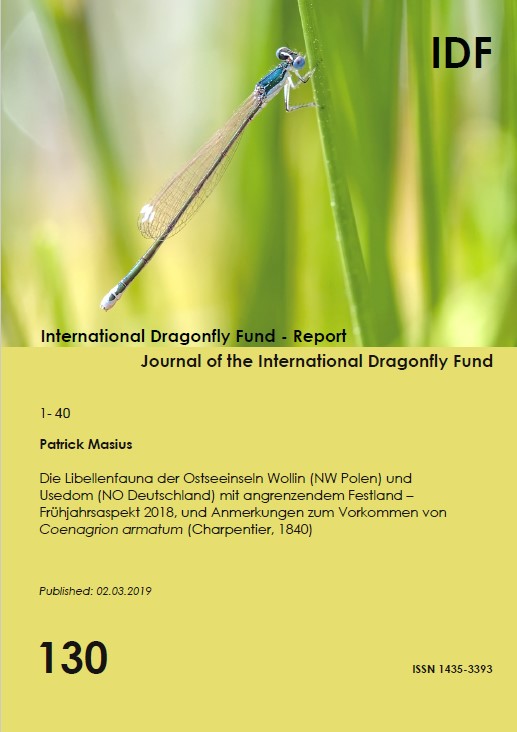
IDF-Report 130: Patrick Masius (2019) – Die Libellenfauna der Ostseeinseln Wollin (NW Polen) und Usedom (NO Deutschland) mit angrenzendem Festland – Frühjahrsaspekt 2018, und Anmerkungen zum Vorkommen von Coenagrion armatum (Charpentier, 1840). 40 Seiten, 50 Farbfotos, 3 farbige Karten, 12 Tabellen
In May 2018, 34 dragonfly species were recorded on Wolin (21), Usedom (30) and the adjacent mainland (21). The most frequent spring species in the area were Coenagrion puella, Libellula quadrimaculata, C. pulchellum, Ischnura elegans, Erythromma najas, Brachytron pratense and Cordulia aenea. C. lunulatum and Calopteryx virgo were recorded for the first time on Usedom, while Anax parthenope, Libellula fulva and Leucorrhinia caudalis were recorded for the first time on Wolin. The occurrence of Coenagrion armatum, which had been recorded in 2016 on Usedom, could not be confirmed. The quantitative results of the survey are given for different types of water bodies (ditches, pools, ponds, lakes, bog lakes). The average number of species per water body was highest in bog lakes (7.5) and lowest (3.4) in temporary pools. In comparison to older studies from the area, the flight season started 13.7 days earlier in 2018 than in years documented prior to 1989. This might be explained by climatic changes. The species composition, however, has remained rather stable – at least on Usedom and the mainland. On Wolin, climatic factors as well as habitat loss and transformation have led to a species composition that is different from the one recorded in the first half of the 1970s.
Key words: Germany, MecklenburgVorpommern, Poland, West Pomeranian Voivodeship, Coenagrion armatum, phenology, Historical comparison
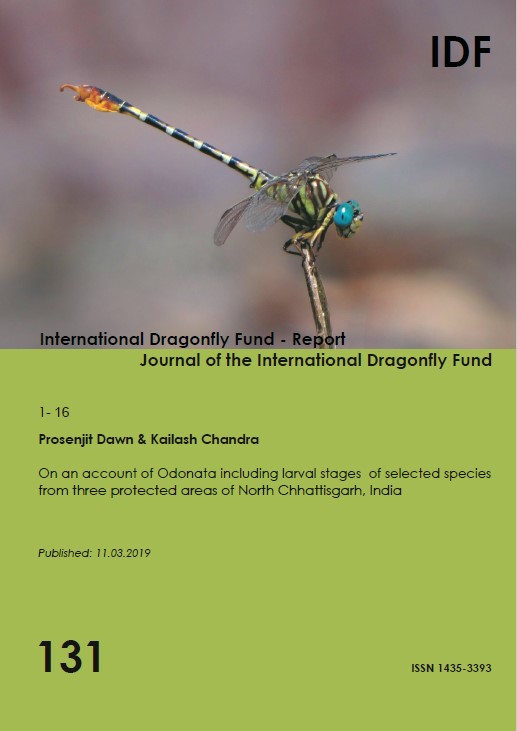
IDF-Report 131: Prosenjit Dawn & Kailash Chandra (2019) – On an account of Odonata including larval stages of selected species from three protected areas of North Chhattisgarh, India. 16 Seiten, 22 Farbfotos, 6 farbige Karten, 1 Tabelle, 5 Grafiken
Survey in three protected areas of Chhattisgarh reveals the presence of 50 species of Odonata belonging to 34 genera and 9 families. Specimens were sampled from different lotic and lentic ecosystems. 17 species were exclusively found in or around running water. Larvae or exuviae of 23 species were found and photographed. Habitat availability, larval abundance, species composition and phenology are discussed.
Key words: Odonata, dragonfly, damselfly, Chhattisgarh, larvae, exuviae, lotic, lentic
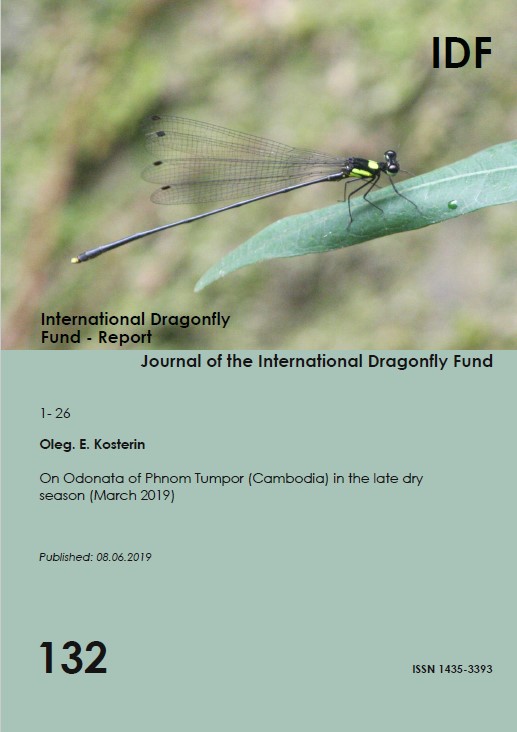
IDF-Report 132: Oleg Kosterin (2019) – On Odonata of Phnom Tumpor (Cambodia) in the late dry season (March 2019). 26 Seiten, 54 Farbfotos, 2 farbige Karten
Phnom Tumpor is a scarcely accessible basalt table mountain in the Cardamom Mts. in Pursat Province of Cambodia. On top surface it bears tall evergreen forest (ca 1100 m a.s.l.), concealing a slow rivulet, O’Gran, being a chain of deep pools. It was examined odonatologically on March 1418th, 2019. Six common species were recorded in dry and burnt scrub on the Phnom Tumpor slopes and ten on the forested upper surface at O’Gran, among them Polycanthagyna erythromelas (Selys, 1891) and Macromia sp. cf. pinratani Asahina, 1987 for the first time in Cambodia. The peculiarities of the males of Coeliccia kazukoae Asahina, 1984 from Phnom Tumpor and the problem of distinguishing females of M. pinratani and M. moorei are discussed.
Key words: Cambodia, Pursat Province, Cardamom Mountains, Phnom Tumpor, Phnom Dalai, Odonata, dragonflies, damselflies, Coeliccia kazukoae, Anax immaculifrons, Polycanthagyna erythromelas, Macromia pinratani, Macromia moorei.
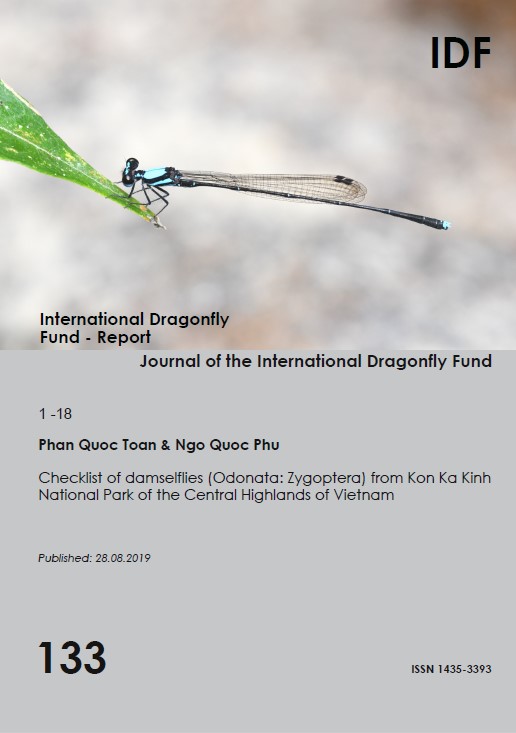
IDF-Report 133: Phan Quoc Toan & Ngo Quoc Phu (2019) – Checklist of damselflies (Odonata: Zygoptera) from Kon Ka Kinh National Park of the Central Highlands of Vietnam. 18 Seiten, 45 Farbfotos, 1 farbige Karte, 1 Tabelle
Kon Ka Kinh National Park, situated in Gia Lai Province of the Central Highlands of Vietnam, was established in 1986. It has a management area of 417.8 km2. The park has been selected as to one of the ASEAN Heritage Parks on account of its high biodiversity. However, the Odonata fauna from this area is poorly known with only six recorded damselfly species: Coeliccia lecongcoi Phan, 2019, Cryptophaea vietnamensis (van Tol & Rozendaal, 1995), Indocnemis marijanmatoki Phan, 2018, Indocnemis orang (Förster in Laidlaw, 1907), Indolestes cyaneus (Selys, 1862) and Sinolestes editus Needham, 1930 (Phan 2018, 2019; Phan et al. 2018, 2019; To & Phan 2019). Here we provide a checklist of 50 damselfly species from 12 families collected from six different sites in the Kon Ka Kinh National Park during six field trips between 2013–2019. The female of Protosticta socculus is described for the first time. We provide records of Burmargiolestes cf. laidlawi and a brief comparison between this species and B. melanothorax (Selys, 1891), including a discussion of its distribution. Three recorded species, two Coeliccia Kirby, 1890 and one Protosticta Selys, 1885 have not been described and will be published in the future.